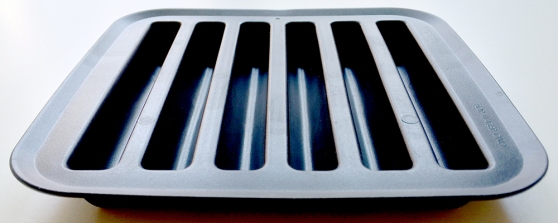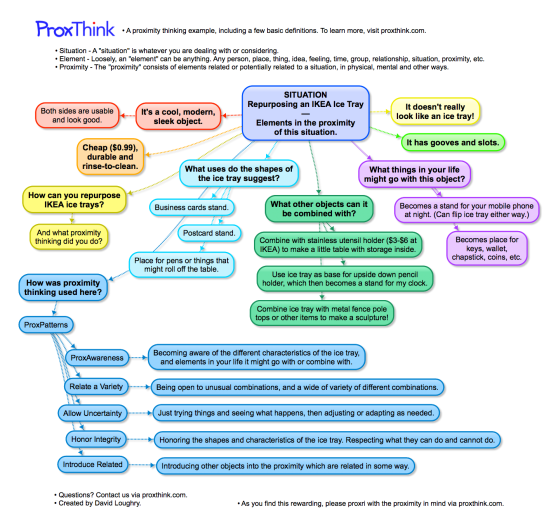Hello,
Are you, as an individual or in your organization, exploring ways of thinking about and relating to situations that could make more progress on the big and small challenges you face, and humanity faces? Whether you’re exploring or not, what follows will expand your possibilities. First, these four definitions will help with what’s coming up. A situation is whatever you are dealing with or considering. An element is anything you’re considering as separate, including a person, place, thing, idea, feeling, time, group, relationship, etc. A relationship is any kind of association or connection between elements. And, the proximity consists of elements related or potentially related to a situation, in physical, mental and other ways. With the proximity thinking framework I created, you can consider situations and challenges with the four basic terms situation, element, relationship and proximity. Although considering elements, relationships and the proximity may each be important in dealing with situations, sometimes one or two of them may dominate our attention and activities, even when that is less effective. You may see that many of our approaches for dealing with challenges, which are kinds of situations, tend to be more element-oriented and/or relationship-oriented. For example, approaches like markets, politics and hierarchies are typically more element-oriented and/or relationship-oriented, meaning they have a greater focus on elements and/or relationships than proximities. No doubt, certain kinds of situations are most effectively dealt with by element-oriented and/or relationship-oriented approaches. However, some of the big and small challenges we face are shared situations, and may be more context-related or environment-related, or may relate to diverse elements across areas that may not typically be connected, so they are more proximity-oriented. And, sometimes it’s easier and more effective to consider a proximity, such as when relationships between elements are hard to define or in flux much of the time, so element-oriented approaches become difficult. Plus, sometimes it just becomes clear that we need to focus on a proximity. For example, consider shared challenges like climate change, sustainability, shared projects, shared spaces, shared resources (whether big like water or power sources or small like parks or kitchens), or shared events (whether big like a festivals or conventions or small like potlucks, picnics or meetings). These kinds of shared challenges are more proximity-oriented. In these kinds of challenges, it can help to relate more directly to the proximity of the situation. Networked technologies, when combined with some new proximity-oriented processes I’ve developed, let us relate more directly to proximities.
While developing the proximity thinking framework, I created some new proximity-oriented approaches that let us relate more directly to proximities. How? By deploying the four ProxThink growth model processes of RelatePoints, ProxMonitors, Vadi Agreements and ProxRewards (proxri) on a collaborative, networked, mobile platform. The ProxThink growth model was developed to work with networks, and grew partly out of asking myself, if you want to relate to a proximity sort like we relate to a person, what would be needed? A RelatePoint is a primary starting point or place for coordinating relationships in the proximity, and is similar to the ability to meet and/or talk to someone. A Proximity Monitor, or ProxMonitor, provides greater awareness of and information about the proximity, similar to the feedback we get from facial expressions, voice tonality, body language, and of course what someone is saying, when we relate to them. Similar to commonly accepted standards of behavior and ways of interacting with people are Vadi Agreements. The term Vadi (pronounced vah’dee) is short for valuable differences. Vadi Agreements acknowledge that differences are a part of relationships and some differences have value, and provide relationships and agreements which can help valuable differences persist, adapt and change as needed. ProxRewards (proxri) are somewhat similar to the need, when dealing with someone, to provide encouragement, positive feedback, rewards, and so forth, which help one or both of you, and which keep the relationship flowing. So a ProxReward is a reward which relates elements in the proximity, and is often a reward made with the proximity in mind. ProxRewards are also called proxri for short (pronounced prox’ree).
When deploying the four growth model processes discussed above on a collaborative, networked, mobile platform, you have proximity-oriented approaches that are integrated conceptually and technologically. With them, people can relate more directly to the proximity of their shared situation. These approaches can help us make more progress on the big and small challenges humanity faces, but also everyday challenges and shared situations. In the process, these approaches help create more sustainable proximities and sustainable variety. It’s both fascinating and a nice surprise that these approaches can make our lives more sustainable as well as more interesting, healthy and vital with more variety. I think sustainable variety is closely related to what nature does, which is perhaps a clue that these approaches have value and potential.
The proximity-oriented conceptual and technological approaches mentioned above come together in a specific form in the collaborative and mobile Shared Situation Guide. You can use it for shared situations with friends, family, coworkers, neighbors and others. It works on your Android phone or iPhone, your tablet and your computer. I’d like you to try it. It helps your group relate more directly to the proximity and each other, improving shared situations. It turns the proximity into more of a tangible, living thing, making it easier to relate to. It also gives people chances to relate to the proximity and each other in a wider variety of ways. Combined, these things can help groups with a shared situation come alive and thrive, and life becomes more enjoyable. There may be other people in proximities you share who are already using the guide, or if not, you can start collaborations that others can join. Keep in mind that the Shared Situation Guide is a preliminary implementation of proximity-oriented approaches, and more will need to be done to integrate the processes it uses into our systems and lives. Learn more, access and try the Shared Situation Guide, find guide workshops, access guide starter sets, and discover other people who are using it, at sharedsituations.wordpress.com.
If you explore the proximity thinking (ProxThink) framework and the Shared Situation Guide, you’ll learn more about and use the concept of proxri, briefly introduced above. You’ll also see that the framework and Shared Situation Guide are offered via proxri. Proxri in practice are sort of like the give and take of a neighborhood, relationship, friendship or perhaps being a considerate traveler. How do you proxri? Basically, you consider the proximity, including your benefits, your circumstances, the other party’s circumstances, and some wider context, and then proxri as appropriate. A proxri may include money, things, services, ideas, tasks, relationships, actions, and so on, as well as a combination of these. So a proxri to me for the framework and guide might also be a referral, consulting or speaking engagement, teaching gig, grant, or other opportunity. In addition, I’ve created a collaboration deal so that people who collaborate on or improve the framework and guide can get proxri. If you think my work might be, or is, useful, interesting or has potential, please consider a proxri for it. You can find out more about my circumstances via this ProxMonitor. You can learn more about proxri here. You can make financial proxri here or via the proxri links on most any page of proxthink.com. As far as non-financial proxri, you can let me know about them by contacting me via the contact methods mentioned below.
Please contact me with any questions, comments, or for other related reasons, via the contact links on the Shared Situations or ProxThink websites. Also, if you’d like to get involved in growing the shared situations approach on various levels (social, technical, legal, organizational, etc.), please get in touch.
Thank you,
David Loughry
Shared Situations website: sharedsituations.wordpress.com
ProxThink website: proxthink.com



